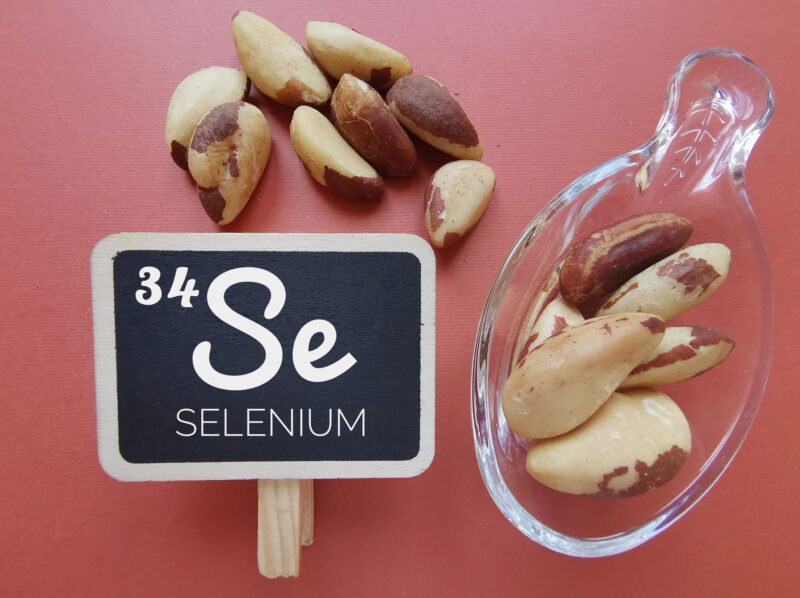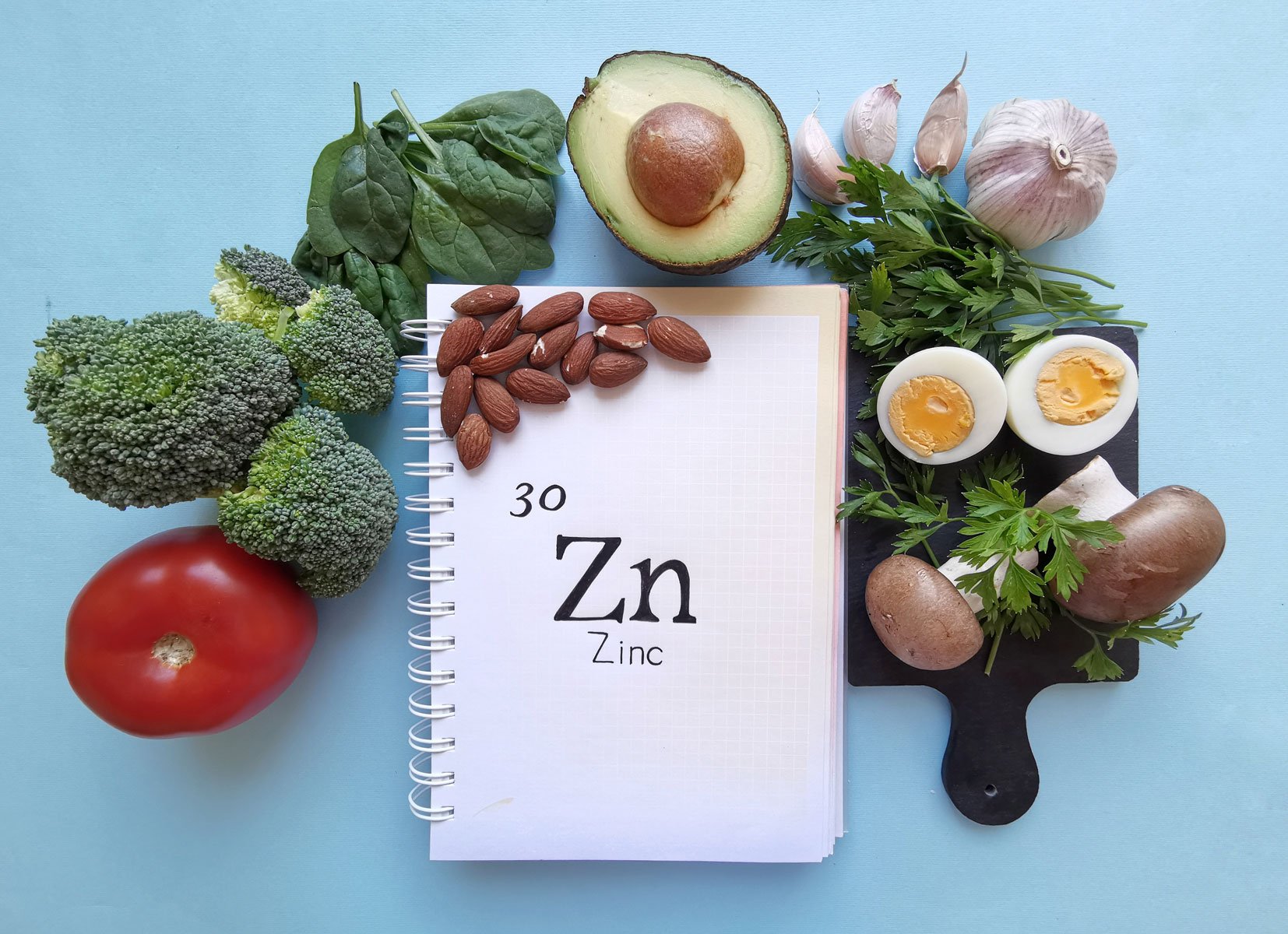Selenium may not get as much hype as some other micronutrients—say, magnesium or vitamin D—but this essential trace mineral plays several roles in metabolic health: It’s a key component of fighting oxidative stress, it supports optimum levels of thyroid hormones (which, in turn, influence energy expenditure along with the metabolism of fat, glucose, and protein), and it may support a healthy insulin response when consumed in appropriate quantities.
Here, we’ll dive into the role of selenium in metabolic health and how to make sure you’re getting enough.
What Is Selenium, and How Does It Affect Metabolic Health?
Selenium is an essential trace mineral, which means it’s required for normal bodily functioning in relatively small amounts compared to macrominerals like calcium and magnesium. Within the body, selenium undergoes a series of reactions to form the amino acid selenocysteine. Selenocysteine is then incorporated into 25 proteins and enzymes, collectively dubbed “selenoproteins,” which influence metabolic health—primarily via their roles as antioxidants and regulators of thyroid hormones.
Many selenoproteins, such as glutathione peroxidase (GPx), thioredoxin reductase, and selenoprotein P, function as antioxidants to neutralize free radicals and prevent excessive oxidative stress. Helping to maintain healthy concentrations of these antioxidant enzymes with adequate selenium is crucial, as unchecked oxidative stress can cause cellular damage and inflammation that promotes insulin resistance, cardiovascular disease, neurological disorders (e.g., Alzheimer’s), various cancers, and overall metabolic dysfunction. Selenium also has a synergistic effect with other antioxidant nutrients—it regenerates vitamin E and vitamin C from their oxidized forms, leading to greater overall antioxidant protection.
Other selenoproteins called iodothyronine deiodinases are highly concentrated in the thyroid gland, where they’re needed for thyroid hormone synthesis and metabolism. Specifically, deiodinases can remove an iodine atom from inactive thyroid hormone (T4) to generate active thyroid hormone (T3). This is vital for metabolic and overall health since every cell in the body relies on thyroid hormone to regulate its metabolism. For instance, thyroid hormone increases basal metabolic rate (essentially, the rate at which you burn calories for energy while at rest), which is necessary for maintaining a healthy body weight and body temperature; it supports healthy body composition and strength by stimulating the development of type II “fast-twitch” muscle fibers that power short, explosive bursts of physical activity; and it supports healthy central nervous system functioning, which can impact mood and energy levels. Several thyroid disorders are associated with low selenium levels.
Finally, there is an interesting relationship between selenium intake and diabetes risk. Selenium can influence insulin signaling and secretion through its antioxidant effects, and it’s even been said to have an insulin mimetic effect—meaning that it may function similarly to insulin and promote the entry of glucose into tissues, thereby lowering blood glucose levels. Surprisingly, though, several epidemiologic studies have found high selenium levels in the body or high supplemental doses (typically 200 mcg or more) may actually have a pro-diabetic effect.
So, what’s the consensus? According to a recent research review, several studies have found a U-shaped relationship between selenium levels in the body and Type 2 diabetes, metabolic syndrome, and insulin resistance—meaning both low and high levels were associated with increased risk. But association doesn’t equal causation, and the review authors note that supplementing with selenium “doesn’t appear to be a major causal factor for developing insulin resistance or Type 2 diabetes in humans.” In fact, the authors point out high blood glucose can actually trigger selenoprotein synthesis in the body—so elevated selenium levels found in diabetes patients could more likely be a result, rather than a cause, of metabolic problems. Still, aiming for optimal but not excessive selenium levels is important.

8 Micronutrients essential for metabolic health
Micronutrients are like tools that help our cellular machinery function better. Here's how they work, and how to ensure you're getting enough
Read the ArticleHow Much Selenium Do You Need?
According to the National Institutes of Health, the daily selenium requirements are:
- Men, 19+: 55 micrograms (mcg)
- Women, 19+: 55 mcg (60 mcg if pregnant, 70 mcg if breastfeeding)
Selenium is needed in trace amounts and is relatively accessible via dietary sources in the U.S. unless you’re consuming a restricted diet (think: vegan or vegetarian). It’s important to emphasize that getting too little or too much selenium can potentially be problematic—you want selenium levels in the body to stay within a healthy, relatively narrow window. Benefits tend to be maximized when serum selenium levels fall between 90–120 µg/L.
The RDA of 55 mcg per day for most adults was established based on the amount needed to maximize the synthesis of the selenoprotein GPx—and this should be the minimum you consume from combined dietary and supplemental sources. Some studies suggest this RDA could be suboptimal and recommend closer to 200 mcg per day from food or a combo of food and supplements. This doesn’t, however, mean that you should supplement with 200 mcg per day on top of your normal diet—consider 200 mcg more of a cumulative selenium cap.
What do experts say? While there’s some debate, authors of a recent research review suggest modestly increasing selenium intake (by 50-100 mcg per day) via food and supplements if your selenium status is low (less than 89 µg/L).
Also, keep in mind the data on supplements is mixed. While they can help bring selenium levels into a healthy range if you’re low, studies have shown both benefits (particularly for certain thyroid conditions) and risks of taking doses of 200 mcg or more. Your likelihood of experiencing benefits or downsides likely depends on your health status, baseline selenium levels, and the supplement dose. That’s why it’s always a good idea to work with a medical professional to identify your personal needs.
Whatever you do, always stay below the tolerable upper limit of 400 mcg per day, as excess selenium is linked to nervous system abnormalities, hair loss, skin lesions, and more.
How Do You Test Your Selenium Levels?
There are a variety of ways to assess your selenium status. Serum or plasma selenium tests are the most common—many labs consider levels below 70 µg/L indicative of recent inadequate selenium intake, but as mentioned above, levels below 89 µg/L could be regarded as suboptimal and levels between 90–120 µg/L are considered optimal based on the latest research.
A urine test can also assess recent selenium intake by measuring selenium excretion, with levels below 15 µg/L considered inadequate and above 50 µg/L considered excessive. Hair and toenail tests can assess longer-term selenium intake. Toenail tests, in which toe nail clippings are collected and analyzed for mineral content and other substances, are generally considered better than hair because they have a more consistent growth rate.
Signs of a mild to moderate selenium deficiency may include muscle weakness, anxiety, confusion, depressed mood, whitening of the fingernail beds, and loss of pigmentation in the hair and skin, while more significant selenium deficiency may contribute to male infertility and impaired immune system function, and negatively impact heart muscles and joints.
Doctors don’t routinely test for selenium or other micronutrients. The decision to test will depend on your symptoms, risk factors, and current health status. While selenium deficiency isn’t common (on average, U.S. adults get 93-134 mcg per day from food and 108-151 mcg per day from food and supplements), certain conditions may predispose you to have low levels.
Some groups at risk for selenium deficiency include people undergoing kidney dialysis, which removes some selenium from the blood; people with HIV, possibly due to inadequate intake or absorption; and people with GI disorders such as Crohn’s disease, which interfere with nutrient absorption. In these cases, other nutrients may also be low. Following a vegan diet may also put you at risk for selenium deficiency.
Where you live also matters to an extent. Soil concentrations of selenium vary by region and influence how much selenium is present in plant foods. Compared to other countries (e.g., China, New Zealand, Eastern European countries), U.S. soil has higher selenium content, but it’s still variable. Concentrations are generally higher in Midwest and Western states and lower in the Northwest, Northeast, Southeast, and Great Lakes region—and the extensive transport of food helps curb risks associated with living in a low-selenium region unless you only eat local.
If your doctor doesn’t think you fit the criteria for testing, but you’re still curious, consider seeking out a functional medicine doctor or dietitian who can order appropriate nutrient lab testing—for example, the NutrEval FMV test by Genova Diagnostics uses blood and urine to assess the body’s needs for vitamins, minerals, antioxidants, and other biomarkers.
What Are the Best Foods for Selenium?
Eating more selenium-rich foods is an effective way to get your fill of this mineral, which is readily found in animal products like meat, fish, and seafood, and some plant foods. You’re unlikely to ingest excessive amounts of selenium from diet alone unless you regularly eat Brazil nuts—a particularly potent selenium source. To be safe, stick to 1-2 Brazil nuts per day.
Some of the top sources of selenium include:
- Nuts + seeds: Brazil nuts (68-91 mcg per nut), sunflower seeds (18.6 mcg per ¼ cup)
- Seafood: canned tuna (72.5 mcg per can), halibut (47 mcg per 3 ounces, cooked), canned sardines (45 mcg per 3 ounces), shrimp (40 mcg per 3 ounces, cooked)
- Meat: ham (42 mcg per 3 ounces, cooked), beef steak (33 mcg per 3 ounces, cooked)
- Poultry: turkey (31 mcg per 3 ounces, cooked), white meat chicken (22 mcg per 3 ounces, cooked)
- Dairy: 1% milkfat cottage cheese (20 mcg per cup), 1% milk (8 mcg per cup)
- Eggs: 15 mcg per large hardboiled egg
- Lentils: 6 mcg per cup, boiled
- Whole grains: brown rice (19 mcg per cup, cooked), oats (13 mcg per cup, cooked)
Some processed foods like macaroni and bread also contain selenium, but these aren’t recommended, as they contain refined grains that are highly likely to spike blood glucose levels.
What About Selenium Supplements?
Because selenoproteins act as antioxidants and influence thyroid hormones, selenium supplements have been studied for their impact on thyroid conditions, Type 2 diabetes, neurological disorders, cardiovascular disease, and more—but results of supplementation so far are largely mixed and inconclusive:
- Autoimmune thyroid disease: A review of 69 studies on selenium and thyroid health identified several studies in which 200 mcg of selenium per day reduced circulating levels of thyroid autoantibodies (the ones that attack your own thyroid and contribute to disease), but their impact on symptoms and thyroid function isn’t clear. The ongoing CATALYST trial, which is assessing the impact of selenium supplements (200 mcg per day) on the quality of life of autoimmune thyroiditis patients, may provide more insight.
- Type 2 diabetes: In a research review on selenium intake and diabetes risk, several (but not all) studies showed a link between selenium supplements and Type 2 diabetes or its risk factors. In one study, skin cancer patients taking 200 mcg of selenium per day were more likely to be diagnosed with Type 2 diabetes in subsequent years if they had higher baseline selenium levels to begin with—suggesting that supplementing when you don’t need to may have metabolic consequences, not benefits. While selenium supplements are unlikely to increase diabetes risk in healthy people, you’re better off skipping if you have high selenium status already or diabetes risk factors.
- Cardiovascular disease: In a trial of adults with relatively low selenium status, taking 100, 200, or 300 mcg selenium per day for 6 months lowered total cholesterol and non-HDL cholesterol compared to a placebo group—and the 300 mcg dose significantly increased HDL. However, other research is mixed, with some studies finding no reduced risk of CVD or cardiac death with selenium supplementation of 100-200 mcg per day (either alone or as a mixed antioxidant supplement). A Cochrane research review also found no significant impact of selenium supplementation on cardiovascular events.
Since most Americans get above the RDA for selenium anyway, taking an isolated, high-dose selenium supplement may not be necessary—and could potentially cause harm. Another strategy: Eating a varied diet and taking a daily multivitamin-multimineral supplement (which typically contains a reasonable 55-mcg dose of selenium), which would most likely provide enough selenium to optimize concentrations of selenoproteins and support health.
If you choose to take a supplement, consider one that contains selenomethionine, which is more efficiently absorbed than other forms of selenium, like sodium selenite. Opting for a lower dose selenium supplement (50-100 mcg) can help you better control your intake. Keep an eye out for indicators of selenium excess when supplementing, too, which include garlic breath, a metallic taste in the mouth, brittle hair and nails, hair loss, nausea, diarrhea, fatigue, and irritability.
Also, keep in mind that selenium supplements may interact with certain medications, including cisplatin (a chemotherapy agent) and valproic acid (an anticonvulsant).
Want to learn more about your metabolic health?
Levels, the health tech company behind this blog, helps people improve their metabolic health by showing how food and lifestyle impact your blood sugar, using continuous glucose monitoring (CGM), along with an app that offers personalized guidance and helps you build healthy habits. Click here to learn more about Levels.








